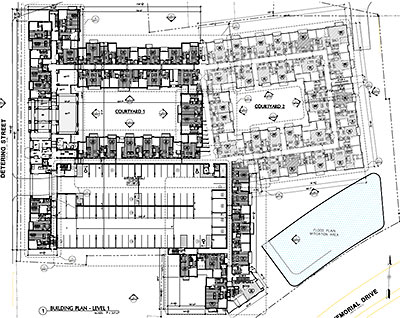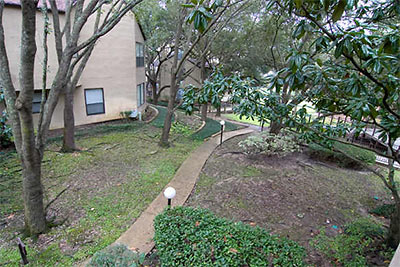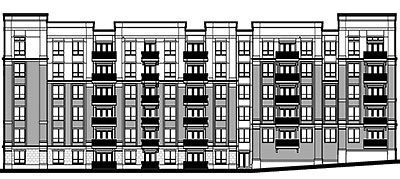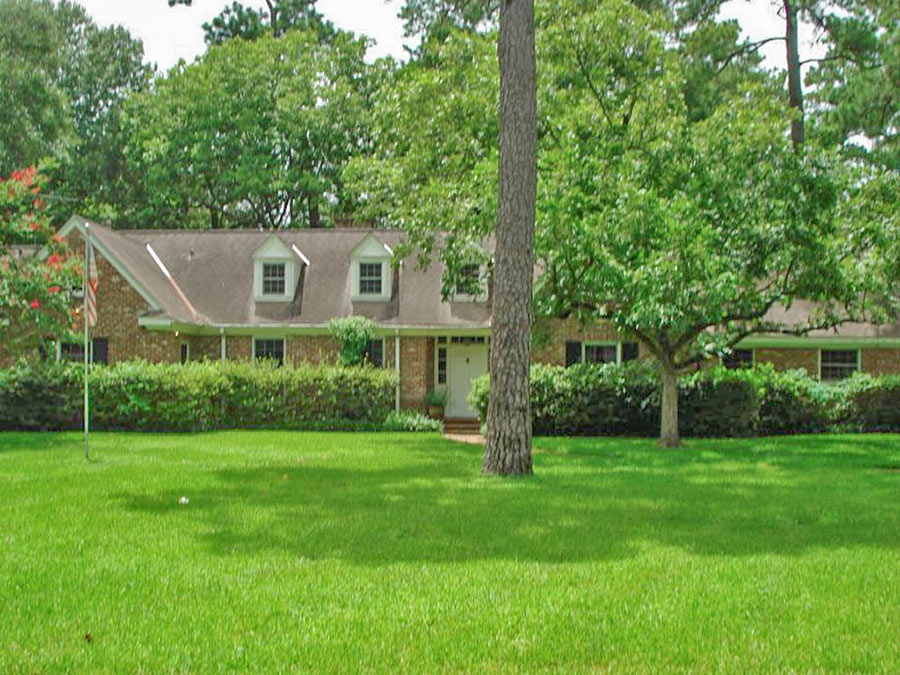

Plans for the 5- and 6-story complex Wallace Garcia Wilson Architects has designed for the new owners of Park Memorial at 5292 Memorial Dr. show that the former grounds of the park-like 108-unit Rice Military condo complex (pictured in better days above) will soon be home to 372 new apartment units. The new project by JLB Partners, currently out to bid, will fit buildings surrounding 2 courtyards, a narrow 7-level garage, and a detention pond onto the 4.85-acre site at the corner of Memorial Dr. and Detering. That’s the plan at the top. And below are a couple of elevations, in different scales, of the west and east sides:
***


The Park Memorial Condos were shut down by the city in 2008. Unable to live in their homes, unit owners were kept in litigation-fueled limbo until this past May, when JLB bought them all out. According to the plans, the new development will keep the name of the now-demolished project it replaces. It’s labeled Park Memorial Apartments — though this time the correct pronunciation will likely have the accent on the word Memorial.
- Park Memorial coverage [Swamplot]
Photo: HAR. Plan and elevations: Wallace Garcia Wilson Architects





I know this is going to launch a hundred comments re-hashing density, mixed use, blah blah blah, but here’s my question. Why does EVERY inner loop apartment project going up right now ( except Regent Square) have to be a 5-6 story brick and stucco building? Are Houston developers just that conservative? Looking around Dallas, there have been multiple mixed use retail/apartment projects built in the last 2 years, many of which are mid-rise or better ( 10-20 floors) and have some interesting modern architectural elements. They seem to attract upwardly mobile young professionals on a career track with no kids who want to be part of the urban “scene”. I thought real estate development involved building something not like everything else in order to charge more rent. Is there no room in the inner loop rental market for a 15 story tower with skyline views and a trendy bistro/nail salon/fro-yo place at street level with parking above?
ShadyHeighsteryou are absolutley correct in your opinion!
Shady, the numbers do not work for a 15-story high rise unless you can get very high rents, say $2.50/sf in most cases. The mixed-use element is a romantic idea, but it only works in high traffic high visibility locations where retail would logically work.
Dallas is different in part because their Uptown district is considerably smaller than our Inside the Loop area. Dallas’ Uptown is a well designed pedestrian neighborhood. With some exceptions, our Inside the Loop is not pedestrian and doesn’t lend itself to the same kind of mixed use development in Dallas’ Uptown. The big attraction to Dallas’ Uptown is the high concentration of live and play opportunities, interspersed with office buildings. Houston’s Inner Loop is wonderful in many respects but the live and play opportunities are spread out over a much larger area.
@shady: I will save everyone some time. Summary of the usual swamplot responses to any suggestion that developers could do better:
-free market
-no zoning
-buy land yourself if you don’t like it
-better than vacant condo property
-building stuff that only lasts 20-30 years means that Houston is always building something newer and better and never gets mired down in great architecture or well planned and liveable urban areas
Houston is following the Paris approach with an endless sea of buildings all at the same height interspersed with some taller ones.
The main reason has to do with rental rates as already mentioned. Houston already has a big list of high-rise high-end apartments spread throughout the inner loop. Most ranging from 15-30 stories (no condo towers).
Another reason is that there is still many patio/townhome options that end up costing similar to the high-rise apartment and some are for rent. Why pay $1400 for a one-bedroom high-end apartment when you can get a 1500-2000sq-ft patio or townhome for the same price.
Also, this particular site is NOT suitable to mix-used development. The section along Memorial is part of the parkway section and is not conducive to pedestrian activity. The corner of Detering and Memorial has an office building. The other portion along Detering is not a commercial street.
If this development was on Memorial just a block to the west, then yes is could be great mixed-use opportunity.
Agree with LandMan. It is only in the last year or two that developers had the confidence in attainable rents to even go beyond 4-5 story wood frame.
As for ground-floor retail, a couple points: such space is more expensive to build, meaning either required rents will be higher and less competitive with retail-only (strip center) space, or the developer has to look at such space as a loss leader, which makes financing more expensive and the whole project less feasible. Add to that the facts that our thoroughfares (where retail wants to be) don’t allow on-street parking and the inability of on-site population to provide enough market demand, and ground-floor retail will be uncommon in Houston for a long time.
Remember also that you can’t have retail everywhere. Even dense cities like Chicago and San Francisco have many all-residential areas with little or no retail. I noticed in Chicago how many streets had mid and high rise multifamily buildings with no retail. These streets were intersected every so many blocks by commercial streets lined by 1-story or low-rise retail / commercial – just done in a more walkable design than what you see in Houston, no fronting parking lots.
Land_Man and kjb:
Thanks to both of you for your insights. I recognize that this particular tract would not lend itself to any type of retail, I was on a more generalized rant after seeing multiple developments announced here on Swamplot in the last few months that all look basically the same. However, the West Dallas project near the Whole Food probably would be able to suppoert the kind of development I’m talking about , as would many blocks of midtown, had the city’s silly setback rules not been enforced in that area.
One project I saw last week in Dallas was the Mondrian at CityPlace. Looking at their website for this 20 story building, rentals run from $1.70 to $1.89 a square foot. Because it is in an area with other dense mixed use apartments/retail, there are indeed lots of eating/drinking/ shopping options for residents in a 3 block walking distance.
Paris is mostly all lowrise because they have extemely strict zoning, something Houston will not have within the next 20 years, if ever. Except for FAA height limits on the Hobby flight path, you can build as tall as you want here.
Land_Man, since you seem to know Uptown Dallas, can you tell me if the pedestrian layout you talk about happened as part of some master plan by the city, or was it just an organic response to the neighborhood?
You guys are crazy if you think that rental rates aren’t already $2.50/sqft in the trendier areas in town. Rates have gone up year after year, my place started at $1200 for 700sqft 3 years ago, the newest notice I got in the mail was that my rent is going up to $1350, and I know new renters moving in that are paying $200-300 more a month for apartments smaller than mine. I’ve looked around for cheaper options with the same amenities within the loop and I can’t find them.
kjb434: I’d love to rent a 2000sqft townhome in a nice part of the inner loop for $1400, where are you seeing these magical uber cheap listings?
“never gets mired down in great architecture or well planned and liveable urban areas”
Dude, Houston is by definition a “livable” urban area, because lots of people live there. They might not be living according to their tastes, it’s true, but that’s your problem, not theirs.
the reason is the developers actually want to build something. if we had more projects like “Regent Square,” we’d have a lot of empty fenced-in lots.
Hard for me to believe, but I have to agree with kjb434 on this one. Mixed use just wouldn’t work at this location. And the Paris analogy had occurred to me as well. When we think of cities with sustainable, dense, non-slum neighborhoods, one should think of Paris (or various parts of Brooklyn). You don’t need tall buildings to achieve density.
Of course for every person who likes what they are are doing in Dallas, there are others who hate it:
http://www.salon.com/2012/05/19/urban_entertainment_districts_blocks_where_no_one_has_fun/
From the linked story… “If you took all the clichés about horrible urban design and shoved them into 75 acres, you’d probably end up with something pretty close to Dallas’ Victory Park. A pre-planned billion-dollar collection of imposing hyper-modern monumental structures, high-end chain stores, enormous video screens, expensive restaurants, a sports arena and tons of parking, completely isolated from the rest of the city by a pair of freeways, Victory Park is like the schizophrenic dream of some power-hungry capitalist technocrat.
@Spoonman: By your force of logic, Lagos, Nigeria is more liveable than Houston because 7.9 million people live in Lagos.
Jason,
I assure you that a developer cannot reliably underwrite $2.50/sf rents in Houston. You may find such rents in a particular unit in a development, but you will not find a large scale development pulling this kind of rent outside of a few very well located high rises. For the kind of development we are talking about here, $2.50 is only a starting point. High land costs and high construction costs dictate rent levels, and both components seem to be going up.
Shady, Dallas’ Uptown started with Southland (?) owning a massive tract (City Place) and planning it wisely. Their timing was lousy (mid to late 80s) but the result has been well received. The City also helped by installing a trolly along McKinney which helped spur apartment, retail and restaurant development. Not to be overlooked in all of this is the role of TH developers (often pioneers) and large apartments developers (Columbus, which was absorbed into Post years ago) and Gables.
You can compare what Dallas did with its Uptown to what Houston has done with its Midtown (which enjoys similar locational advantages being close to the CBD and the art/museum district) and it’s not even a close call. Midtown’s relative disappointment is a mystery to me–I think it could have been so much more.
“@Spoonman: By your force of logic, Lagos, Nigeria is more liveable than Houston because 7.9 million people live in Lagos.”
Yep, that’s why ‘livable’ is an idiotic term to use when describing a city.
I would agree that some of what keps houston from having multi-story aprtments and condos is the abundance of affordable, close in, freestanding townhomes that have popped up in montrose, Rice Military, etc., in the last 10 years or so.
My other concern is that when we have an area where developers throw up relatively cheap, 4 story wood frame, brick and stucco skinned apartments, what happens when these developers pay off/sell their projects and move on? Do these become the “gulfton ghettos” of Houston in the 2030’s? Remember that Sharpstown was full of what people thought of as “luxury apartments” in their day.
Colonial House, all over again. It’s coming.
Shady has nailed it in post 17. All the new growth inside the loop is great, for now. But the shelf life for these apartments is about 15-20 years before they either need a major overhall or let the place decay and drop rents to keep the place full or get torn down and replaced, possibly after being vacant for years. It ends up being a chicken and the egg problem for Houston. Developers want to be assured a certain $ per sq ft in rent before they are willing to do something that will really generate the kind of area that people will be willing to pay those kind of dollars for rent. But, when no one is willing to take the risk, the area becomes saturated with honeycombs for the worker bees and never becomes desirable for the quality of life. Thus, mediocrity begets mediocrity.
Jason,
My house in Cottage Grove by TC Jester and I-10 is 1600 sq-ft. It shares a driveway with 7 other homes behind a gate. You have no common walls and your own garage. The house has hardwood floors, stainless appliances and all the upgrades…it’s three bedroom and two baths.
All this can be yours for only $1300 a month (and I’m still making money on it).
My renters just re-upped for another year and will be moving out July 2013. Would be interested in renting it then?
Yes, you can rent homes for cheaper.
This development is proof that virtually none of the people commenting on Swamplot have even the vaguest notion what they are talking about, or even where these developments are located. If they did, they would have known that the former Park Memorial Condos (R.I.P. Unit H-18) sat next to a 4 lane limited access parkway, between a garden style condo and a midrise apartment, across from two rather large apartment complexes, and adjacent to a rather hideous…but very pricey…assortment of 5 (yes, 5)story townhomes. There is virtually no area to place retail that could be DRIVEN to, much less walked.
Having lived on the side of the hill in the back of the complex for 5 years, my personal preference would have been for townhomes stairstepping down the hills of this unique topography. However, economic realities may not have allowed such, and besides, that is my little dream.
I challenge the readers and posters of Swamplot to break free of your urban cliches! Seriously. These things you pine for, nay, demand, don’t work! They never do. Read that Salon article. Victory Park may be the crown jewel of failed urban cliches, but other failures abound. If you actually took the time to look at all that “ground floor retail” that you demand…and the City of Dallas required…you’d find it all empty. Why? Because those newly built urban developments are prohibitively expensive. No friendly merchants can afford to operate there.
Look, there is nothing wrong with a retail center across the street from the midrise apartments. They are easier to walk to, drive to, park at, and make a profit operating in. Yet, because there are no apartments above it (really, who would like to see Old School living in an efficiency above a bar), everyone screams bloody murder. Well, get over it. It ain’t happening in the real world.
Shady,
I’m sure the bust that occurred in the 80’s played a significant role in Sharpstown decline.
But the shelf life for these apartments is about 15-20 years before they either need a major overhall or let the place decay and drop rents to keep the place full or get torn down and replaced
=================================
Before anyone reads this and thinks it makes any sense, please drive by the Belmont Apartments on Bissonnet between Buffalo Speedway and Kirby. They were built in 1991 and pretty much kicked off the modern era of apartment development in Houston (post 80’s bust). They are in FINE condition at the ripe old age of 21 years.
There are plenty more early 90’s vintage complexes around that are also going strong and aging well. Vanderbilt Square (1995). Inverness (1991). Pin Oak Green etc. (1991). City Scape. City Walk. And MANY more. There is nothing wrong with these 20 year old complexes.
Finally, take a look at Westchase or Avalon Square and you’ll see 50 year old apartment complexes that are still fine places to live.
Yes. Buildings age. And deteriorate over time. But well located assets in high demand sub-markets where the rental rates are high enough to finance proper maintenance can stand the test of time.
Cars need to go slower on Memorial Drive and this could be a good walking neighborhood. This is a very dangerous section between Detering and Westcott. Lots of bikers, walkers, runners, dogs, and a busy starbucks.
That is an actual improvement, that was a homeless hotel previously. Since it was condemned they could do nothing but a total tear down and start anew. While I’m sure it will be another add water and stir brick and stucco complex, it’s in a great location, and compared to the giant stucco 4 story monstrosities behind it, it will be somewhat low key by comparison. The density is the norm now, the once quiet Rice Military neighborhood is already over run with stucco, yuppies, etc, so any semblance of quaint is already long gone (which is why I moved). Not to mention Washington Avenue continues to get more douchey by the day. Give it 20-30 years and you’ll likely see this same cycle repeat, as Park Memorial was built in 1982.
Corey, Park Memorial was pretty much a teardown BEFORE the property was condemned. The original builder went bankrupt before the buildings were completed back in 1981. The banks hired contractors to finish them so that they could be sold off. Unfortunately, this meant many of the units were poorly constructed (1981 was not a good building heyday in the first place). Many of the walls had too few studs in them, the stucco was not applied correctly, and the drainage was poor. Every project to rehabilitate the property ran double or triple budget.
It was an engineering study that was leaked to the City that caused the condemnation. While the City clearly overreacted, the engineering study was not pretty, finding many looming problems. This is what prompted the residents to get together to market the property en masse. The cost to rehab was more than the residents could bear.
Park Memorial is not an example of what happens to apartments after 20 years. It is an example of what happens to structures that weren’t built right in the first place.
I’m surprised no one has asked about what will happen to Detering, now that we’ll have an additional 200 people driving through (and all their drinking buddies). Oh wait, I know – nothing. Nothing will be done. Silly me.
I read the condemned notices (orange) posted around the site, I lived within walking distance from 2001-2010; that the buildings were condemned because the parking lot was in danger of eminent collapse; which sounds right in line with your further info; thanks Dave. Probably had crap aluminum wiring too.
@ Brinn and every other commenter who complains that new density in the urban core will bring cars and traffic:
Is the City somehow supposed to prevent the growth in traffic that’s characteristic of every other successful U.S. big city? Look, growth in the core means drivers will sit in more traffic and parking will get more expensive and difficult. As many people will choose to drive as can fit (or not fit) on the streets. There’s really not much that can be done unless you want to cap development, which of course won’t and certainly should not happen in Houston. If traffic and parking utterly define Houston’s quality of life then we’re not much of a city; the degradation of those features won’t significantly hurt people’s lives or take away their freedom, in my opinion, because Houston has so many other things to offer.
Now, if you want to have a discussion about developing other ways of getting around, that’s a talk worth having…
Well it is interesting to note that the main building that was considered unstable managed to stand on its own amidst all the rubble and activity around it almostfour years after the property was vacated. As to the traffic issue, if I am reading the plan correctly, there is only one entrance whereas the old Park Memorial had three. I thought multi family properties of this scale needed more than one entrance when possible? There was a big flap about a proposed condo site in the Heights w Camelot(?) over that issue a few years back.
@Local Planner – I’m fine with rising density, so long as the area can accommodate it. While the site itself can handle an influx of 200+ people, adding that many cars or more to a street like Detering isn’t going to work. The street is much too narrow already, there are no sidewalks (which means people walk in the street) and there is little if any street parking. What that translates to is these 200+ people getting jammed up on Detering, lots of illegal parking that blocks traffic (furthering the problem) and increased danger/likelihood of pedestrians getting hit by cars.
Now if Houston was smart, they would put in light rail, sidewalks and make roads the appropriate width so two cars can pass one another (or make them one way streets). However, those are not happening at the same rate that new developments and thus, density, are occurring. These need to be simultaneous to work well – that’s what is frustrating. Cram in the people until they can’t get in our out and only then do we discuss solutions to fix it which take a decade to implement. Cart and horse, anyone?
Brinn, far too many jurisdictions restrict density pending future transport investment. Then the investment never comes, or the train gets built and then local NIMBYs protest the upzone. Houston lets the growth happen and then adds the infrastructure once there’s proven demand.
That area is already mixed-use, it’s just horizontal rather than vertical. If I lived in these apartments I would walk to the Kolache Factory down Memorial, full stop. Likewise I might use my bike to get to downtown Houston, using some of the bike infrastructure along Buffalo Bayou which is constantly being improved. Memorial in the vicinity of Detering definitely needs better sidewalks, but the pace at which the bike/ped infrastructure is being improved within the Inner Loop is absolutely mind-blowing.
You can already ride from downtown to 610 without ever touching a road on your bike..
True dat. But for the segment of Memorial from Crestwood to just before Shepherd, the “bike path” is a standard four-foot sidewalk, which is too narrow.
Given the pace of bike infrastructure improvement in Houston, though, I wouldn’t be surprised if this was widened sooner rather than later.
Drove past the old place this morning and saw the rubble pile from the demolition. Interesting the last building still partially standing is the exact building with the “immently dangerous foundation” problem that started this mess. I’m still at a loss as how the CoH was able to run us out of our homes so quickly (30 day eviction) which ruined some of our credit ratings when we were forced into foreclosure?
Sorry about my misspelling of “imminently” in previous post.